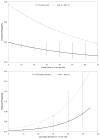Linking deforestation to malaria in the Amazon: characterization of the breeding habitat of the principal malaria vector, Anopheles darlingi
- PMID: 19556558
- PMCID: PMC3757555
Linking deforestation to malaria in the Amazon: characterization of the breeding habitat of the principal malaria vector, Anopheles darlingi
Abstract
This study examined the larval breeding habitat of a major South American malaria vector, Anopheles darlingi, in areas with varying degrees of ecologic alteration in the Peruvian Amazon. Water bodies were repeatedly sampled across 112 km of transects along the Iquitos-Nauta road in ecologically varied areas. Field data and satellite imagery were used to determine the landscape composition surrounding each site. Seventeen species of Anopheles larvae were collected. Anopheles darlingi larvae were present in 87 of 844 sites (10.3%). Sites with A. darlingi larvae had an average of 24.1% forest cover, compared with 41.0% for sites without A. darlingi (P < 0.0001). Multivariate analysis identified seasonality, algae, water body size, presence of human populations, and the amount of forest and secondary growth as significant determinants of A. darlingi presence. We conclude that deforestation and associated ecologic alterations are conducive to A. darlingi larval presence, and thereby increase malaria risk.
Figures



References
-
- Singer BH, de Castro MC. Agricultural colonization and malaria on the Amazon frontier. Ann NY Acad Sci. 2001;954:184–222. - PubMed
-
- Vasconcelos CH, Novo EM, Donalisio MR. Use of remote sensing to study the influence of environmental changes on malaria distribution in the Brazilian Amazon. Cad Saude Publica. 2006;22:517–526. - PubMed
-
- Yasuoka J, Levins R. Impact of deforestation and agricultural development on anopheline ecology and malaria epidemiology. Am J Trop Med Hyg. 2007;76:450–460. - PubMed
-
- Vittor AY, Gilman RH, Tielsch J, Glass G, Shields T, Lozano WS, Pinedo-Cancino V, Patz JA. The effect of deforestation on the human-biting rate of Anopheles darlingi, the primary vector of Falciparum malaria in the Peruvian Amazon. Am J Trop Med Hyg. 2006;74:3–11. - PubMed
MeSH terms
Grants and funding
LinkOut - more resources
Full Text Sources
Medical
